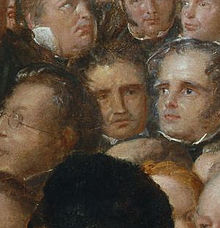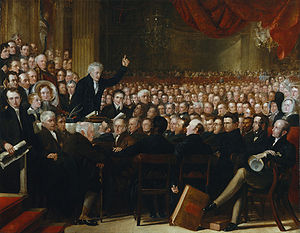- Charles Stuart (abolitionist)
-
Captain Charles Stuart 
Capt. Stuart between Thomas Scales (left) and Sir John Jeremie (right) shown in a detail from The Anti-Slavery Society Convention, 1840, by Benjamin Robert HaydonBorn 1783
JamaicaDied 1865
CanadaEducation Belfast Known for Abolitionist Captain Charles Stuart (1783 – 26 May 1865) was an Anglo-Canadian abolitionist in the early-to-mid-19th century. After leaving the army, he was a writer, but was notable for his opposition to slavery.
Biography
Charles Stuart was born in 1783 in Jamaica of parents who were of Scottish descent. He was educated in Belfast and then pursued a military career as his first vocation.[1]
Stuart is close to the centre in this painting which is of the 1840 Anti-Slavery Convention.[2] Move your cursor to identify him or click icon to enlarge
Stuart left the military in 1815 and, in 1817, emigrated to Upper Canada with a tidy pension.[3] He settled in Amherstburg Upper Canada and began his pursuit of a cause both in Canada and England. By 1821, he was involved with the black refugees who were beginning to arrive in the area from south of the border. He began a small black colony near Amherstburg where he actively assisted the new arrivals to start new lives as farmers.
In 1822, Stuart took a position as the principal of Utica Academy in New York State. There he met a young Theodore Dwight Weld who became one of the leaders of the American abolitionist movement during its formative years. By 1829 he returned to England for a time. There Charles produced wrote some of the most influential anti-slavery pamphlets of the period.[1]
In 1840 he attended the World Anti-Slavery Convention in June. One hundred and thirty of the more notable delegates were included in a large commemorative painting by Benjamin Haydon. This picture is now in the National Portrait Gallery in London.
He retired to a farm near Thornbury, Ontario in 1850 at Lora Bay on Georgian Bay.[4] Any product made from the use of slave labour was forbidden in his home.
References
- ^ a b Captain Charles Stuart, Biography at the Dictionary of Canadian Biography Online, accessed December 2010
- ^ The Anti-Slavery Society Convention, 1840, Benjamin Robert Haydon, 1841, National Portrait Gallery, London, NPG599, Given by British and Foreign Anti-Slavery Society in 1880
- ^ Captain Charles Stuart, abolitionist, accessed December 2010
- ^ Armitage, A: Captain Charles Stuart, abolitionist The Sun Times, May 29, 2009.
Categories:- 1783 births
- 1865 deaths
- American abolitionists
- Canadian activists
Wikimedia Foundation. 2010.

